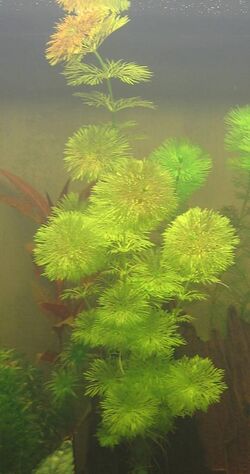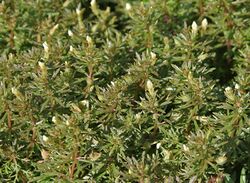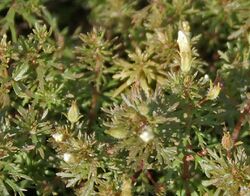Biology:Limnophila sessiliflora
| Limnophila sessiliflora | |
|---|---|

| |
| Scientific classification | |
| Kingdom: | Plantae |
| Clade: | Tracheophytes |
| Clade: | Angiosperms |
| Clade: | Eudicots |
| Clade: | Asterids |
| Order: | Lamiales |
| Family: | Plantaginaceae |
| Genus: | Limnophila |
| Species: | L. sessiliflora
|
| Binomial name | |
| Limnophila sessiliflora (Vahl) Blume
| |

Limnophila sessiliflora, known as dwarf ambulia, ambulis, and Asian marshweed is a flowering plant in the family Plantaginaceae.
Synonyms
Ambulia Ambulia sessiliflora; Hottonia sessiliflora; Stemodia sessiliflora; Terebinthina sessiliflora; Stemodiacra sessiliflora[citation needed]
Distribution
Mainly native to Australia and parts of Southeast Asia, L. sessiliflora has also naturalized in a number of regions where conditions are suitable—likely due to its relevance within the freshwater aquarium and aquascaping hobbies—giving it the unfortunate distinction as a non-native ‘weed’ or an invasive species. Today, it can be found within flooded fields, swamps and rice paddies in southern China , parts of India , Japan and the Philippines .
In North America, the plant has gradually escaped from captivity and naturalized itself in several counties in Florida, ranging all the way from the northwestern Panhandle region to Miami-Dade County in the southern part of the state.[1]
Ecology
Very adaptable; has been found growing in mountain streams, lakes, rivers and even damp soils.[citation needed]
Description

This species appears superficially similar to Cabomba caroliniana, yet it has leaves formed in whorls, about 1.2 inches (3 cm) in diameter. Any confusion is likely due to the leaves being pinnate and bright green in colour. Under strong artificial light or sunlight, the leaves take on a reddish, ‘stresses’ hue, as do many plant species. When the plant has received enough light for the day, the whorls of leaves will often close, and the entire plant will "sleep".[2] This plant can, eventually, reach over 16 inches (40 cm) in height, often growing emergent (out of the water's surface), where sunlight and carbon dioxide is far more available to the plant. The submersed leaves are very different from the emersed leaves, due to lower light penetration through the water, often more dark green, and more or less ‘Lance’-shaped.
The fruit are elliptical capsules, 3.5-5.5 mm long, green-brown when submersed, dark brown when emersed.
Cultivation
Quite commonly used as a bunch plant in aquariums. Needs medium light (more light results in better growth and appearance) and a nutrient-rich water column. Benefits from the addition of CO2. Like many stem plants, it tends to take on a leggy growth in poor light.
Propagated by cuttings.
Growth conditions: Ph 6–7.5 3-25 dGH 3-25 dKH Temperature 22 - 28'C
A nutrient-rich substrate also benefits the plant.
References
- Biswas D, Calder CC. 1955. Handbook of Common Water and Marsh Plants of India and Buram. Health Bull. 24, Delhi, 47 pp.
- Dutta NM. 1975. A Revision of the genus Limnophila of eastern India. Bull. Bot. Soc. Bengal. 29:1-7
- Gilbert KM. 1984. A review of the aquatic plants Limnophila heterophylla and Limnophila sessiliflora. Bureau of Aquatic Plant Research and Control Dept. of Natural Resources. 12 pp.
- Mahler MJ. 1980. Limnophila, a new exotic pest. Aquatics 2:4-7
- Philcox D. 1970. A taxonomic revision of the genus Limnophila R. Br. (scrophulariaceae). Kew Bull. 24(1):101-170
- Rataj K, Horeman TJ. 1977. Aquarium Plants. T.F. H. Publications: Neptune City.
- Sculthorpe CD. 1967. The Biology of Aquatic Vascular Plants. Edward Arnold Publ. Ltd.: London. 610 pp.
- Spencer W, Bowes G. 1985. Limnophila and Hygrophila: a review and physiological assessment of their weed potential in Florida. J. Aq. Pl. Manag. 23:7-16
- Yamazaki T. 1985. A revision of the genera Limnophila and Torenia from Indochina. Journ. Fac. Sci. Univ. Todyo. III 13: 575-624
- Yang YP, Yen SH. 1997. Notes on Limnophila (scrophulariaceae) of Taiwan. Botanical Bulletin of Academia Sinica. pp. 285–294
External links
| Wikimedia Commons has media related to Limnophila sessiliflora. |
Wikidata ☰ Q1768430 entry
 |

